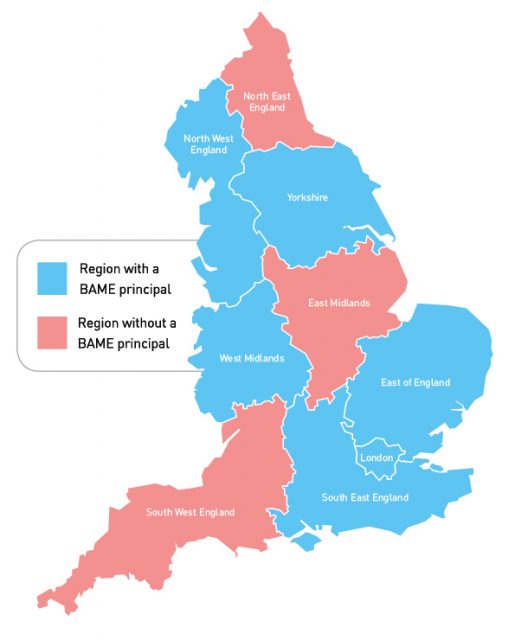The number of colleges led by a non-white principal has fallen to a low of 7 per cent, new FE Week analysis has revealed.
A number of initiatives to encourage and support Black, Asian and Minority Ethnic (BAME) leadership have stalled in recent years and now three of the nine regions in England have no ethnic minority principals at all.
When shown the figures, the Association of Colleges admitted “there are not enough BAME leaders in FE” and said it has set up an equality and diversity steering group in response.
A series of groups aimed at increasing the number of ethnic minority college bosses have ended in recent times, including the disbanding of the AoC’s BAME Principals’ Group in 2017, the failed attempt to revive the Network for Black and Asian Professionals in 2016, and in 2015 the closure of the Black Leadership Initiative, which was launched in 2002.
Ali Hadawi, principal at Central Bedfordshire College – one of just 13 non-white general FE college bosses of 185 identified in FE Week’s study – said he was “not surprised” by the numbers and called for a “programme that targets the under-represented to understand what holds them back”.

He told FE Week he was “fortunate enough” to benefit from two targeted initiatives during his career which no longer exist and were facilitated by the now-defunct Black Leadership Initiative.
These included a shadowing experience offered by Ofsted for BAME FE staff in 2005 and another shadowing senior civil servants to understand how policy development works in FE.
Ofsted is currently developing a similar initiative among schools in London, but it won’t be piloted in colleges.
Hadawi says the sector has shown that it can overcome underrepresentation problems, considering the current number of female college leaders. Of the 185 general FE colleges in England, 52 per cent (97) are women.
“If we look at the work that was done to enable more women principals, then that worked,” Hadawi said.
“So we have a blueprint as a sector and as a country where that has worked very well. That could be extended [to aspiring BAME leaders].”
Data released by the Education & Training Foundation (ETF) last year revealed that 9.8 per cent of college principals or chief executives were from a BAME background.
The fall this year, to 7 per cent, is likely to have occurred partly because of college mergers.
Pat Carvalho, principal at Harrow College, is no longer listed as the top boss for her institution following its merger with Uxbridge College to become HCUC in 2017. Its chief executive is Laraine Smith.
And while Andy Forbes is still the principal at City and Islington College, he’s not classed as the college’s top leader following its merger with Capital City College Group where Roy O’Shaughnessy is the chief executive. More recently, Epping Forest College announced that its principal, Saboohi Famili, was leaving her role as a result of its merger with New City College, where Gerry McDonald is the boss.
The proportion of non-white college bosses does not reflect the country’s demographics. The BAME population stood at 13 per cent at the 2011 census.
“There are not enough BAME leaders in further education, it’s as simple as that,” said Kirsti Lord, AoC’s deputy chief executive. “And this issue goes beyond just leadership roles – there is often a real lack of diversity in governing bodies and the make-up of staffing structures.”
The association told FE Week that its BAME Principals Group was wound up as part of its restructure in years gone by, but its new equality and diversity steering group is aiming to tackle the issue.
It will “keep a focus on increasing diversity in colleges’ workforce and leadership throughout future policy change, recruitment and development initiatives to ensure that this remains at the heart of decision-making and that college leadership is seen as an aspirational, achievable career for all”.

After being shown FE Week’s analysis, Lynne Sedgmore, who led the Centre for Excellence in Leadership (now the ETF) between 2004 and 2008, said: “These figures are very disappointing. When I ran CEL we placed diversity at the heart of our vision and mission and worked tirelessly to increase the number of BAME leaders in the sector at every level. There were no BAME coaches so we paid for 12 to be trained and made available to existing and aspiring black leaders.
“And we also introduced targeted support on the fast-track programmes, which included part- or fully subsidised opportunities for BAME candidates.
“I look forward to the ETF being clear about its leadership commitment to urgently support and develop more BAME leaders along with the necessary financial investment.”
The ETF said it currently offers a number of free places on numerous courses and programmes to BAME staff designed to inspire middle managers to progress. These courses include the Chairs’ Leadership Programme, which usually costs £750; the Leading from the Middle programme, which costs £975; and the Preparing for CEO programme, at £3,750 until November, and £4,500 after that.
Mark Wright, head of leadership development at the ETF, said: “We are very conscious of the need and importance of ensuring that senior leadership in the sector better reflects the ethnicity of our society and of learners. We also recognise there is a long way to go, especially as only 10 per cent of the overall FE workforce is from a BAME background.
“We also offer a one-day leadership course ‘Beyond the Blind Spots’ aimed at senior decision-makers and designed to develop leaders to overcome unconscious bias and seed cultures that are more conducive to BAME leader progression. In addition, we have a BAME mentoring programme which seeks to raise the confidence and capacity of potential BAME leaders.”
Colleges aren’t alone when it comes to a lack of diversity in leadership. Government data shows that just 7 per cent of school headteachers are from an ethnic minority background, and an investigation by FE Week’s sister paper FE Week last year found only 3 per cent of the largest academy trusts are led by non-white leaders.
A Department for Education spokesperson said: “It is vital that the teachers, leaders and governors of FE providers reflect the learners and communities that they serve.
“We provide grant funding to the ETF, which is continuing to develop support for the FE sector by running specific programmes designed to support greater diversity in leadership in the FE sector.”
A note on method
Since the DfE doesn’t publish data on the ethnicity of college principals, we’ve had a go ourselves. We’ve done this by examining photos plus names, and where we thought it necessary, contacting the person in question. We think we’ve managed to arrive at a good estimate but, as always, we are happy to be corrected regarding any errors.
Correction
The original version of this article stated there were 12 BAME principals out of 185 general FE colleges. We have since spotted that we had not counted Nav Chohan from Shipley College in Yorkshire. We updated this story on 15 July to reflect this.








When I first started inspecting 25 years back the vast majority of principals and chairs of governors were white males. Over the years, partly because of the recognition of underrepresentation in inspection reports, the white majority began to change. Although you have not provided figures I know from going into colleges that there has been such a large increase in the numbers of females who are CEOs, principals and chairs that the gender gap is now one that is not so apparent as it once was. Ethnicity is more difficult because the diversity of populations varies in different locations. However if you are a learner you should be seeing staff whose ethnic origin reflects the local population, and with equality of opportunity being promoted well, senior post holders should also be reflective. Inspection reporting has placed less emphasis on underrepresentation in both staffing and in vocational areas. Perhaps this is a timely reminder to get things back into the spotlight so that expectations become reality at all levels.
There is no “gender gap” with regard to the role of Principal. As the article notes, 52% of Principals are female. However, if present trends continue I wonder, at what point, will anyone be concerned about the “reverse gender gap”?
John – people might worry about a ‘reverse gender gap’ [aka a ‘gender gap’] if the number of female principals ever significantly exceeded the overall proportion of the FE workforce which is female. That currently stands at 61%. So some way to go before you need to get worried that male privilege is under sustained and successful attack…